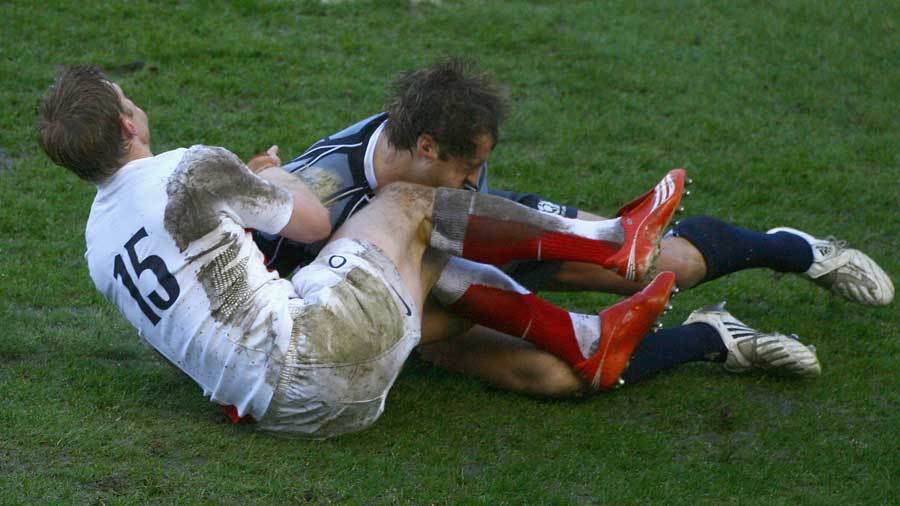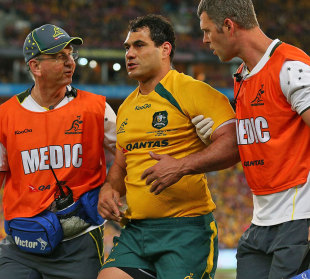|
Rory Lamont on Concussion
'Players are deliberately cheating concussion tests'
Rory Lamont
December 19, 2013

Rory Lamont feels the force of a challenge that led to him needing facial reconstruction to his cheekbone, eye socket and jaw. © Getty Images
Enlarge
Rory Lamont played 29 Tests for Scotland between 2005 and 2012. He retired from the game in 2013 and has written about his experiences of the numerous concussions he sustained while playing the game. Part one saw him speak openly about his worry over the unseen effects of concussion. During my rugby career I was knocked out on 10 occasions, I also suffered dozens of other concussions where I was everything but knocked out. I didn't report many of my 'smaller' concussions to medical staff because I considered them insignificant. The real problem rugby faces is that the concussion tests in place can be easily manipulated by the players to get back on the field before they are fit. When medics were aware of my concussions, I was always given the most incredible level of care and I am eternally grateful for the skill and expertise of those who helped me to recovery but the sport's failings are to do with rugby's culture. After a player has been diagnosed with concussion the 'graduated return to play' (GRTP) protocol is used. This is a series of physical and cognitive assessments in the days and weeks following a concussion to try ensure the player is asymptomatic before returning to training and playing. The Cogsport Test A key tool used in this protocol is the 'Cogsport' (COG) test. This computerised assessment measures cognitive function, particularly memory, concentration and reaction speed. To be declared fit you must reach your baseline score which you set during your pre-season, when you were considered to have 100% cognitive function. Players can view the baseline test as an obstacle in their way for getting back playing. To achieve an accurate score, you must pay full attention. The conflict of interest is this: the better score you set in the baseline test, the more difficult it will it be to pass the test after concussion. Set a high score and you might end up missing more games than you would like; put in 80% effort and it will be easier to pass the COG test after concussion. Players will deliberately cheat the protocol by putting in a sub-maximal effort when setting their baseline. Without maximum concentration and effort, the COG test will be unreliable for identifying if a player is suffering concussive symptoms.

The George Smith incident in the third Lions Test caused concussion to be thrown into the media spotlight
© Getty Images
Enlarge
So who is at fault here? It is clearly the player's responsibility to take the test seriously. But in a job where every game is a chance to win your next contract and keep paying the mortgage, it is easy to understand a player's desire to get back playing. The bravado culture in rugby is another driving force. There is nothing more heroic and sacrificial than to declare yourself available for selection in spite of injury and coaches will often commend such behaviour. If the player is not informed of the long-term health implications, he doesn't know what he is gambling. The evidence suggests it is a gamble of epic proportions, concussion is linked to a host of neurological problems including increased risk of early-onset dementia. It is common to see players return to the field in as little as six days after they were knocked out. Is this a clear signal the system is not protecting players adequately? A bruised leg will struggle to heal in six days, so can a bruised brain recover in that time? Rugby must acknowledge that some players are returning to the field of play earlier than what can be considered safe because they are able to pass a series of flawed assessments. It may well be a case of 'out of sight, out of mind' as we don't see the damage a concussion can cause within the skull, we can forget it's there. Concussion mismanagement is best remedied by education. If a player chooses to cheat the protocol or decides not to report their concussion after being educated of all the possible health risks, then at the very least it is an informed decision. Rugby is a pressure cooker environment - players, coaches and even medics all face demands to get the player back on the pitch as soon as possible. Like the player, a coach's career is on a knife-edge - this can lead them to exert pressure on a concussed player to take the field. I've witnessed this happen. The coach may not utter the words 'you must play' but he has other tools at hand to convince a player they should play down their symptoms and declare themselves fit. It is not uncommon for players and coaches to be in conflict with medical staff who have declared a player unfit to play. This experience can be distressing for a medic, stuck between maintaining good medical practice and consequences of going against the coach's wishes. The medics don't always win these battles and the unfit player takes to the field. This happens even when the player is concussed. It is more common than people realise but I doubt you'd get an honest answer if you asked anyone inside the game - people want to keep their jobs. Coaches may think twice before applying such pressure if they were better informed of the health risks of concussion. The Pitch Side Concussion Assessment
Pitchside Suspected Concussion Assessment (PSCA)
There is considerable debate taking place about the Pitch Side Concussion Assessment (PSCA). The PSCA is the IRB's strategy for dealing with concussion during the game. The five-minute assessment is performed immediately after a suspected concussion. The IRB claims this new strategy has resulted in more concussions being medically reported than ever before. However it could be argued greater concussion awareness is the real force behind the statistical improvement. The problem with the PSCA is a concussed player can pass the assessment. I know from first hand experience it can be quite ineffective in deciding if a player is concussed. It is argued that allowing the five-minutes assessment is better than zero minutes but it is not as clear cut as one might hope. Concussion symptoms regularly take 10 minutes or longer to actually present. Consequently the five-minute PSCA may be giving concussed players a license to return to the field. The PSCA is supposed to be performed only if there is doubt that a concussion has occurred. I suspect nearly every time a medic runs on the field there is an element of doubt whether a player is concussed. A medic will want to be 100% certain that they are not unnecessarily removing a perfectly healthy player from the field, as that would not sit well with the player or the coach. This doubt in the mind of the medic creates an opportunity for a player to undergo the PSCA, pass it and return to the field within minutes of being concussed. There is little doubt that the PSCA is being overused in professional rugby. The gold standard in concussion management should be if a player is suspected of being concussed he should be removed from the field immediately and observed for 24 hours for any symptoms. If there is doubt, 'sit him out'. There must be a drive to minimise human error in concussion diagnosis, to do this we need to utilise any tool available that will minimise the pressure on pitch side medical staff who have an incredibly difficult job. Having an independent medical expert using television footage to catch and immediately flag any possible concussions would result in many more concussions being identified. If it is clear on video that a player has been concussed then they should immediately be removed from the field of play with no need for PSCA, reducing the pressure on pitch side medics. Rugby's Responsibility Rugby must also consider at what point a player is deemed to have been on the receiving end of too many concussions. This is not an easy question to answer. The symptoms of chronic traumatic encephalopathy (CTE) can take decades to develop, just because a player with history of repeated concussions seems fine now, it doesn't mean we shouldn't be doing more to protect him. It is important that medical staff are aware of the concussion history of each player. I played for four different teams in my 10-year career, I would be shocked if any of the medical staff were aware of the number of times I had been knocked out in my career.
Each individual player should have a concussion record, separate from their medical records making it easier for medical staff to identify the number and severity of concussions each player has had. The basic fact is this - rugby is putting too much faith in the reliability of the diagnostic tools used for concussion. On a few occasions in my career I was declared fit after legitimately passing all the concussion assessments, only to endure a recurrence of my concussion symptoms when exposed to the high impacts of a competitive match. We know that even the very best concussion assessments are flawed and therefore it is incredibly hard to justify the minimum six-day exclusion that is currently in place for a concussed player. Until more reliable concussion assessments are implemented, rugby must consider extending the minimum exclusion time to protect those concussed players who are able to pass the assessments. A challenge also remains in combating the current cavalier attitude towards concussion we are seeing. The best remedy to this problem is education but we should not expect this responsibility to lie with employers, this has to be driven from the very top of the game. Better concussion awareness is without doubt going increase the number of players being diagnosed, meaning bigger injury lists for teams. In a sport that struggles to generate a profit this is not good news for employers or investors. But we must ensure player welfare is prioritised above all else. © ESPN Sports Media Ltd
| |||||||||||||||
Live Sports
Communication error please reload the page.
-
Football
-
Cricket
-
Rugby
-
- Days
- Hrs
- Mins
- Secs
F1 - Abu Dhabi GP
Abu Dhabi Grand Prix December 11-131. Max Verstappen ()
2. Valtteri Bottas (Mercedes)
3. Lewis Hamilton (Mercedes)
4. Alexander Albon ()
5. Lando Norris ()
6. Carlos Sainz Jr ()
-
ESPNOtherLive >>
Snooker - China Open
Tennis - Miami Open

